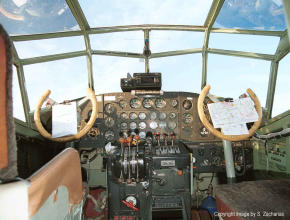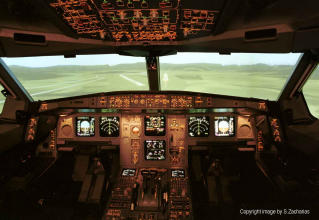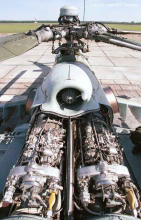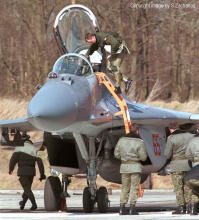No CRT, LCD or any other modern equipment in the cockpit. The Junkers
Ju52/3, affectionately known as Auntie Ju, can well do without any of
those gizmo goodies about 50 years from its first flight. The
greenhouse-like cockpit glass of the beautiful old lady clearly give
it a nostalgic flair.


A simulated approach to Zürich-Kloten airport is here seen on the
visual system of a level-D full-flight simulator. It offers the most
exact reproduction of flight characteristics for training purposes. The
aircraft type in this view is an Airbus A 330 twin-engine longrange transport.
The two Klimov TV3-117 engines of the Mil Mi-24 are mounted on top of the fuselage.
They provide 1400 kW of shaft horsepower, which are transmitted to the main
rotor mast via a reduction gearbox. Below the rotor hub, the swash plate,
the hinges and damping elements of the blades are visible.


The Swedish SF-37 Viggen is a reconnaissance version of the Saab aircraft.
Instead of a radar, its nose carries several cameras, among them a 9x9
inch 600 mm lens. The images are processed on the ground and sent for analysis.
Dressed in his speed jeans and the helmet held under his arm, a MiG-29
Fulcrum pilot enters the cockpit for another mission. Inside the canopy
frame the rear view mirrors are visible and on the nose the FLIR ball and
the cannon muzzle on the portside wingroot are visible. The eye-cueing
of the weapon system make it a formidable weapon, especially in the
close-in air-to-air combat arena. Flown by professional skilled pilots,
the Fulcrum remains a highly respected opponent for western fighter
pilots today.


Aviation accidents do occur and sadly will continue to do so, but
passenger air travel today remains the safest means of
transport. Nonetheless airport fire services are required to hone their
skills in training exercises every second year. This serves to
organise and coordinate the work and capabilites of the different
services, called upon in such an eventuality.